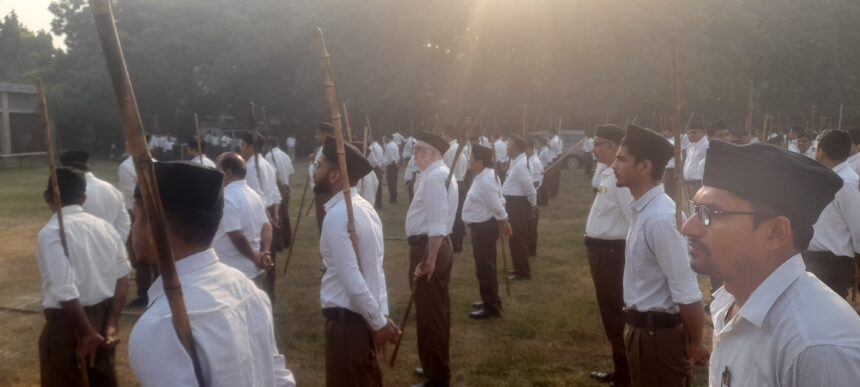Pledge for the World: The Vision of a Harmonious and Organized Hindu Society
Part 2: RSS Centenary Sankalp Blog Series
🇮🇳/🇬🇧
A Pledge for the World Beyond Borders
In March 2025, the All India Pratinidhi Sabha of the Rashtriya Swayamsevak Sangh (RSS) adopted a centenary resolution in Bengaluru. More than an organizational document, it was framed as a pledge for the world—a commitment to build a harmonious and organized Hindu society that would contribute to universal peace.
This pledge for the world connected personal discipline, family integrity, and social unity with a global responsibility. It positioned India not merely as a participant in international dialogue but as a civilization offering a living model of balance between diversity, duty, and harmony.
Harmony and Organization: The Heart of the Pledge for the World
At the core of the resolution are two profound principles: Samras (harmony) and Sangathan (organization).
-
Harmony signifies equality and cohesion. It calls for dissolving caste barriers, bridging regional divides, and ensuring economic cooperation so that society functions as one integrated whole. Harmony in this pledge does not mean uniformity but unity in diversity.
-
Organization refers to collective discipline and clarity of responsibility. It channels individual energies into a higher dharmic purpose, aligning aims and ensuring integrity of leadership. Organization gives the pledge for the world its backbone, transforming lofty ideals into social practice.
Dharma: The Foundation of the Pledge for the World
The resolution insists that this pledge for the world rests upon dharma—the principle of duty, truth, and justice. Dharma is not sectarian ritual but a universal law of balance.
A dharma-based society guarantees:
-
Justice over selfishness
-
Truth as supreme guidance
-
Compassion and non-violence as default conduct
-
Collective welfare as the highest aim
In rooting the pledge in dharma, the resolution ties social progress with spiritual responsibility.
Sajjan Shakti: Exemplary Individuals and the Pledge for the World
No pledge can succeed without trustworthy leadership. Here, the resolution emphasizes Sajjan Shakti—the power of virtuous individuals whose lives radiate moral strength and social dedication.
These individuals, free of narrow interests, are called upon to guide communities, inspire collective confidence, and present India’s image as a nation living the pledge for the world. Their example ensures that ideals are not reduced to rhetoric but translated into action.
Family, Nature, and Nation: Building Blocks of the Pledge for the World
The resolution identifies three foundational structures as essential to the pledge:
-
Life in balance with nature: Humanity must restore ecological harmony and respect the environment as sacred.
-
Families rooted in values: Families are civilization’s primary units. Their strength ensures social continuity.
-
Citizenship devoted to the nation: Loyalty to the motherland provides stability and anchors responsibility toward wider humanity.
Together, these three form concentric circles leading from the self to the world. The pledge for the world must begin at home but cannot end there.
India’s Civilizational Responsibility in the Pledge for the World
The resolution boldly states that India’s role is not limited to its own welfare. The construction of a harmonious and organized Hindu society is a civilizational duty that extends to humanity itself.
For millennia, India has cultivated a worldview where spiritual wisdom balances material progress. By adopting this pledge for the world, India accepts a global responsibility: to share its dharmic perspective with a world struggling with inequality, conflict, and alienation.
Responding to Modern Challenges Through the Pledge for the World
The 21st century is marked by social unrest, climate crisis, and ideological polarization. The pledge recognizes these realities. Its response is not retreat into nostalgia nor blind chase of modernity, but equilibrium—progress with ethics, freedom with responsibility, and innovation with rootedness.
By offering this balance, the pledge provides humanity with a roadmap for peace in an age of turbulence.
A Practical Framework for the Pledge for the World
Beyond philosophy, the resolution proposes concrete steps. The immediate priority is the expansion of shakhas—local branches where discipline, unity, and dharmic training are cultivated.
From this foundation, larger transformations can be realized: awakening individuals, strengthening families, weaving social harmony, securing national integrity, and ultimately fulfilling the pledge for the world.
Transforming the Pledge for the World into Reality
The centenary resolution is both a recognition of past experience and a forward-looking promise. By calling for a harmonious and organized Hindu society, it seeks to demonstrate to humanity that diversity and unity can coexist, tradition and modernity can complement one another, and dharma can anchor peace in a restless world.
The pledge is thus not a dream but a duty. It is a call to action—to live in harmony, to act with discipline, and to radiate peace from the family to the globe. If realized, it will make India not only a participant in world affairs but a guiding light for humanity’s shared future.
Feature Image: Click here to view the image.
Related Videos
Videos displaying the services of RSS to non-Hindu community
Credit https://x.xom/sree_n_r
Credit https://x.com/AshokShrivasta6/
Glossary of Terms
- All India Pratinidhi Sabha: The highest decision-making body of the Rashtriya Swayamsevak Sangh (RSS), consisting of elected representatives who frame key resolutions.
- Centenary Resolution: A declaration adopted in 2025 marking 100 years of RSS, setting forth its vision for global peace and societal transformation.
- Samras (Harmony): A Sanskrit-derived concept meaning equality and cohesion across caste, region, language, and economic status within Hindu society.
- Sangathan (Organization): The principle of collective discipline, unity, and shared purpose that guides social and national progress.
- Sajjan Shakti: Literally “force of the virtuous,” denoting exemplary individuals of high moral standing who guide collective life.
- Dharma: The foundational principle of duty, justice, truth, and righteousness in Hindu philosophy, beyond ritual or sectarian confines.
- Shakha: Local units or branches of RSS where physical, intellectual, and spiritual training are imparted to cultivate disciplined citizens.
- Bengaluru Resolution: The March 2025 decision of the All India Pratinidhi Sabha in Bengaluru that outlined the roadmap for world peace through Hindu social organization.
#HinduinfoPedia #HinduSociety #WorldPeace #Dharma #Unity
Previous Blogs of the Series
Related Blogs
- https://hinduinfopedia.org/rashtriya-swayamsevak-sangh-a-pillar-in-modern-hindu-society/
- https://hinduinfopedia.org/sanatana-dharma-secular-and-inclusive-values-of-hindu-philosophy/
- https://hinduinfopedia.in/nathuram-godse-murderer-patriot-or-fractured-youth/
- https://hinduinfopedia.org/ambedkars-buddhist-political-move-divergence-from-gandhi-on-caste-issues/
- https://hinduinfopedia.org/india-china-border-tensions-a-strategic-analysis/
- https://hinduinfopedia.in/gandhis-murder-was-nehru-involved/
- https://hinduinfopedia.in/waqf-act-debate/
- https://hinduinfopedia.com/abrahamic-religions-alliance-how-global-networks-target-indias-democracy/#Modi_the_RSS_and_the_Abrahamic_Narrative_Trap



Leave a Reply